Using bot rich responses with Livechat
Sample flow how a bot interact and responds with LiveChat
Sample flow
https://imiprodus1org.us.webexconnect.io/flowdesigner/view/public/de56af4a-db1c-4e62-b011-3b67395e35c3 (pass: 123)
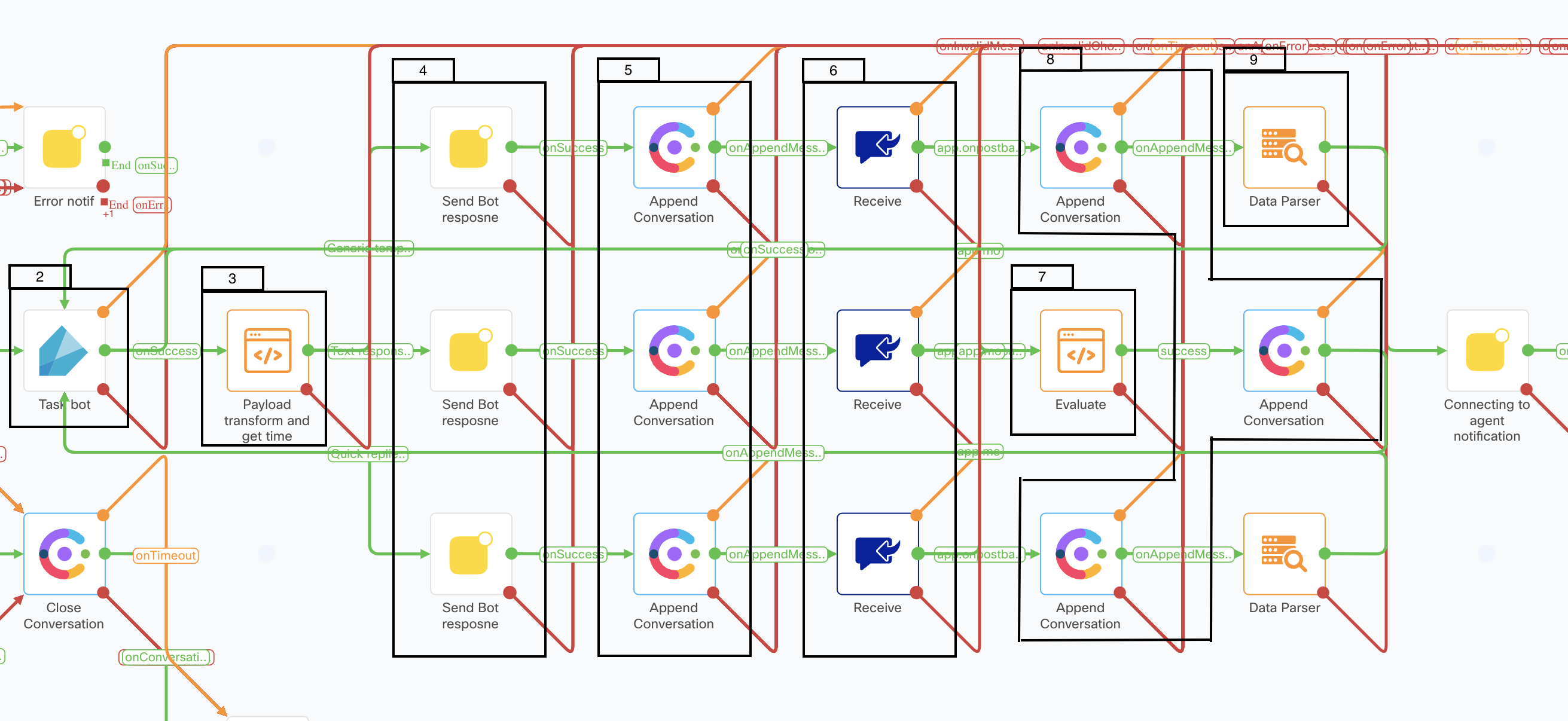
The 'bot loop' part of the flow for using rich responses. The numbers above each box correspond to steps in this documentation.
Steps to use rich responses in a Webex Connect flow
- Define rich responses (quick replies, carousels, etc.) in your bot responses. Refer for more information
- In the bot node, select Set Variable from Action and define 'botresponse' as a Variable and set the Value as 'full_response' output variable.
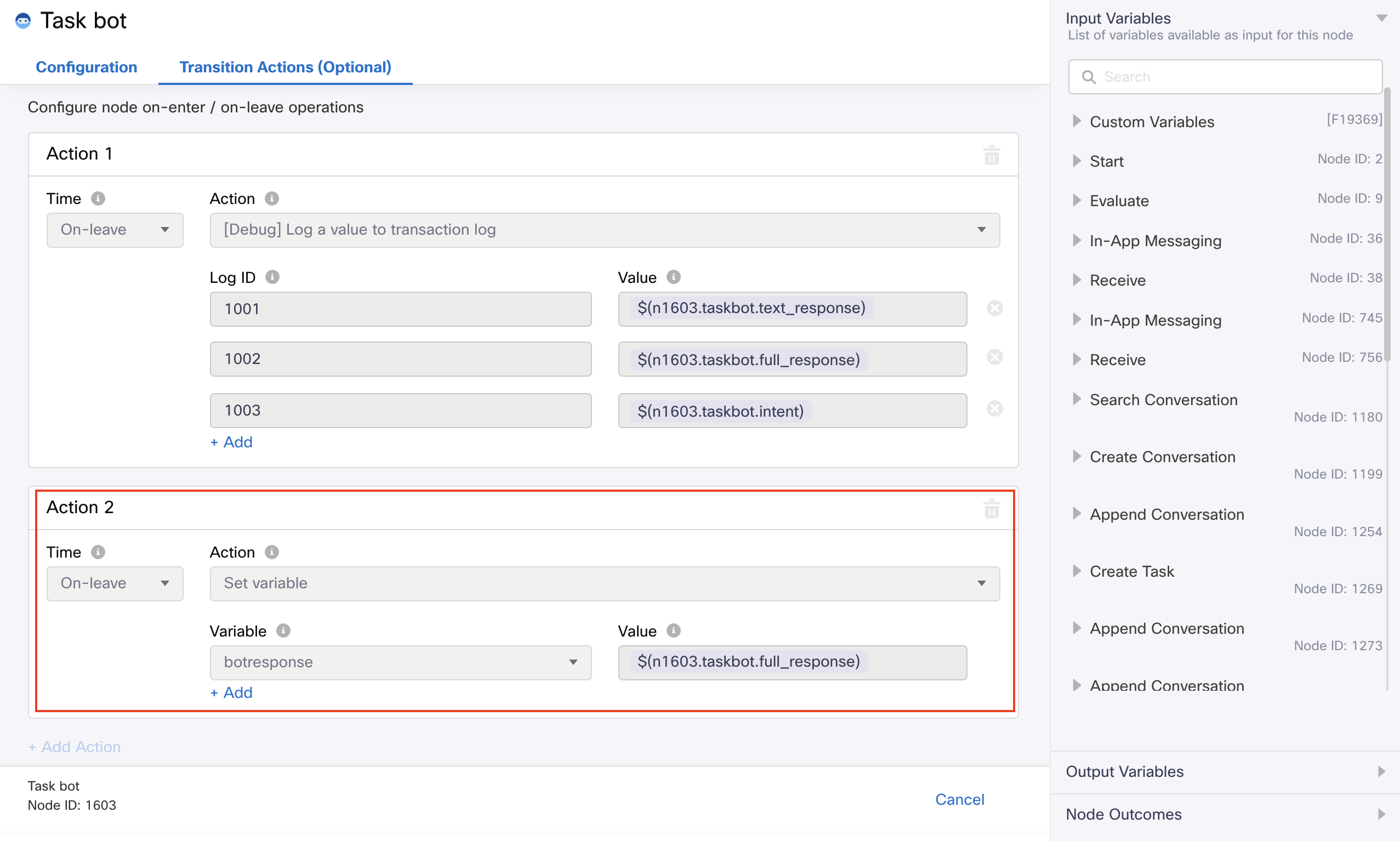
Setting the 'botresponse' variable in bot node.
- Use an evaluate node for 'Success' node outcome of the bot node to parse the bot output and transform it into the format required by the inApp node.
- Use the code provided in the document in the evaluate node.
- Set script outputs for the three possible outcomes
- Text response
- Quick replies with text
- Generic template
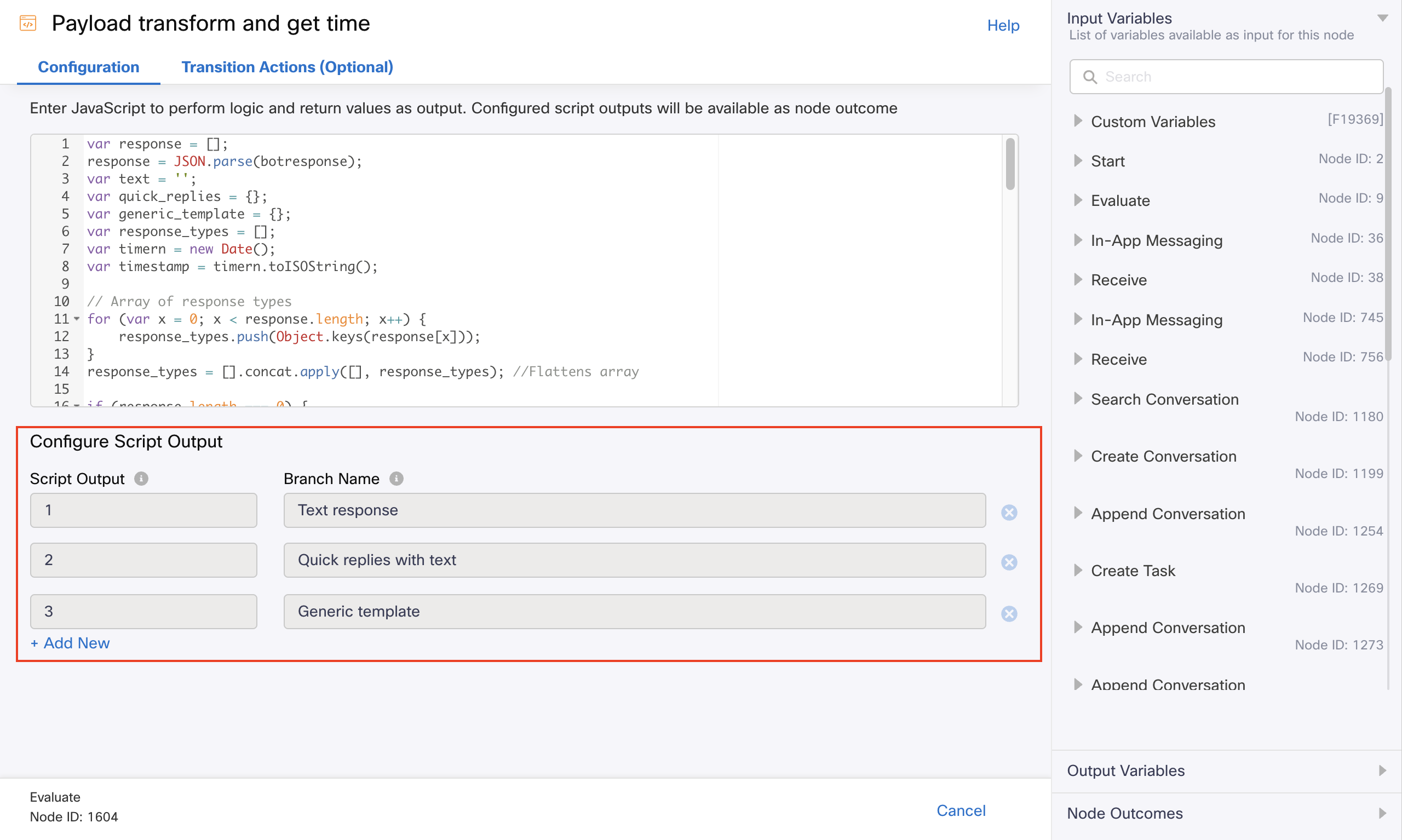
Setting script outputs in evaluate node.
- For each of the three node outcomes, use a different In-app Messaging channel node and select the message type based on the appropriate branch.
- Text response
- Message type = Message
- Message =
$(text)
- Quick replies with text
- Message type = Message with Quick Replies
- Message =
$(text) - Content type = Dynamic
- Quick replies =
$(quick_replies)
- Generic template
- Message type = Generic template
- Message =
$(text) - Content type = Dynamic
- Template Elements =
$(generic_template)
- Text response
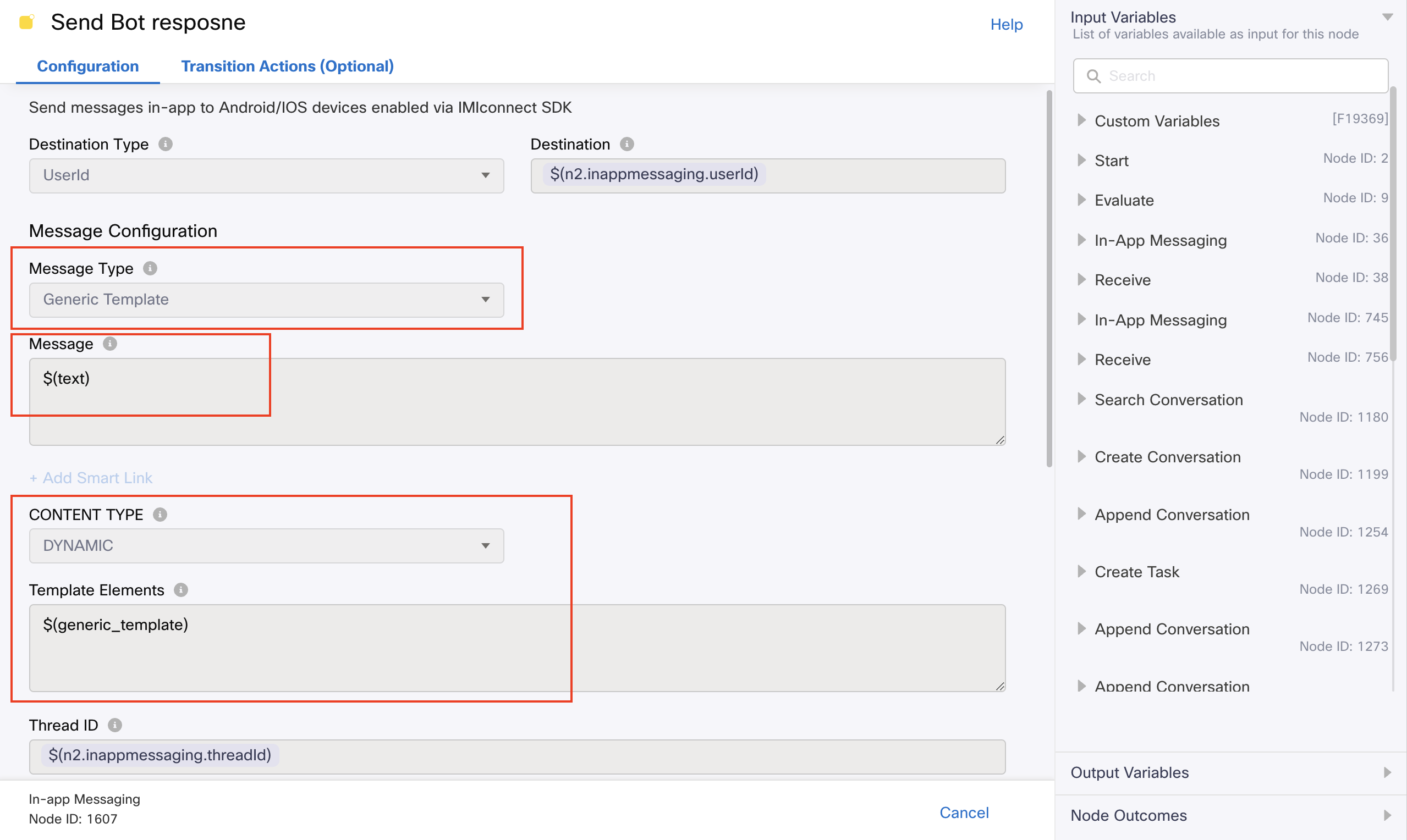
Delivering a generic template/carousel to the user.
- Select the appropriate 'Message Type' in subsequent Append Conversation nodes and provide the values from the preceding channel nodes. Set the Timestamp field as
$(timestamp).
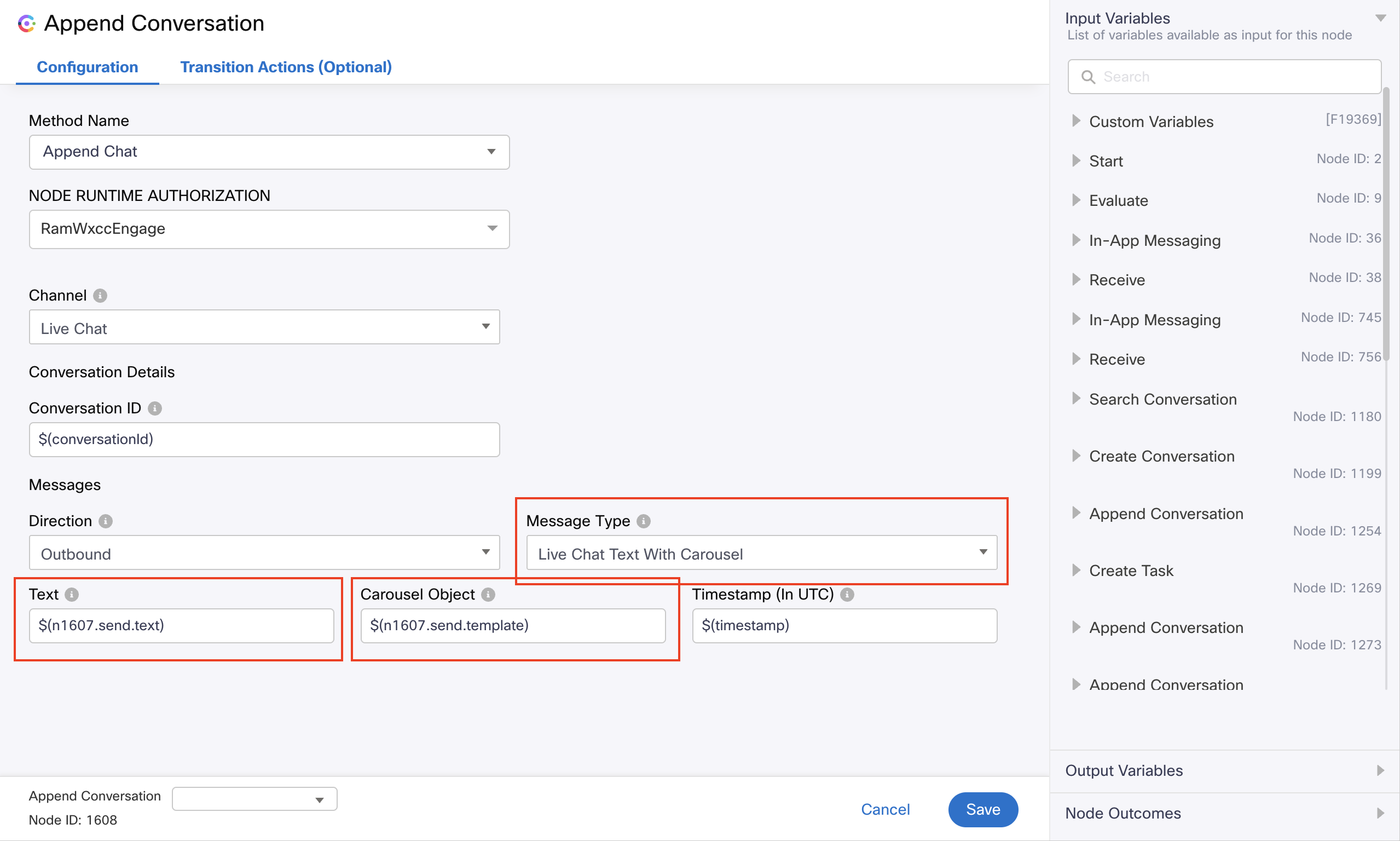
Appending the conversation with generic template.
- Connect receive nodes to Append conversation nodes in each of the three branches. Add 'Incoming message' and 'Postback' event names. Update the value of the variable that is being used as an input message to the bot node when exiting these receive nodes.
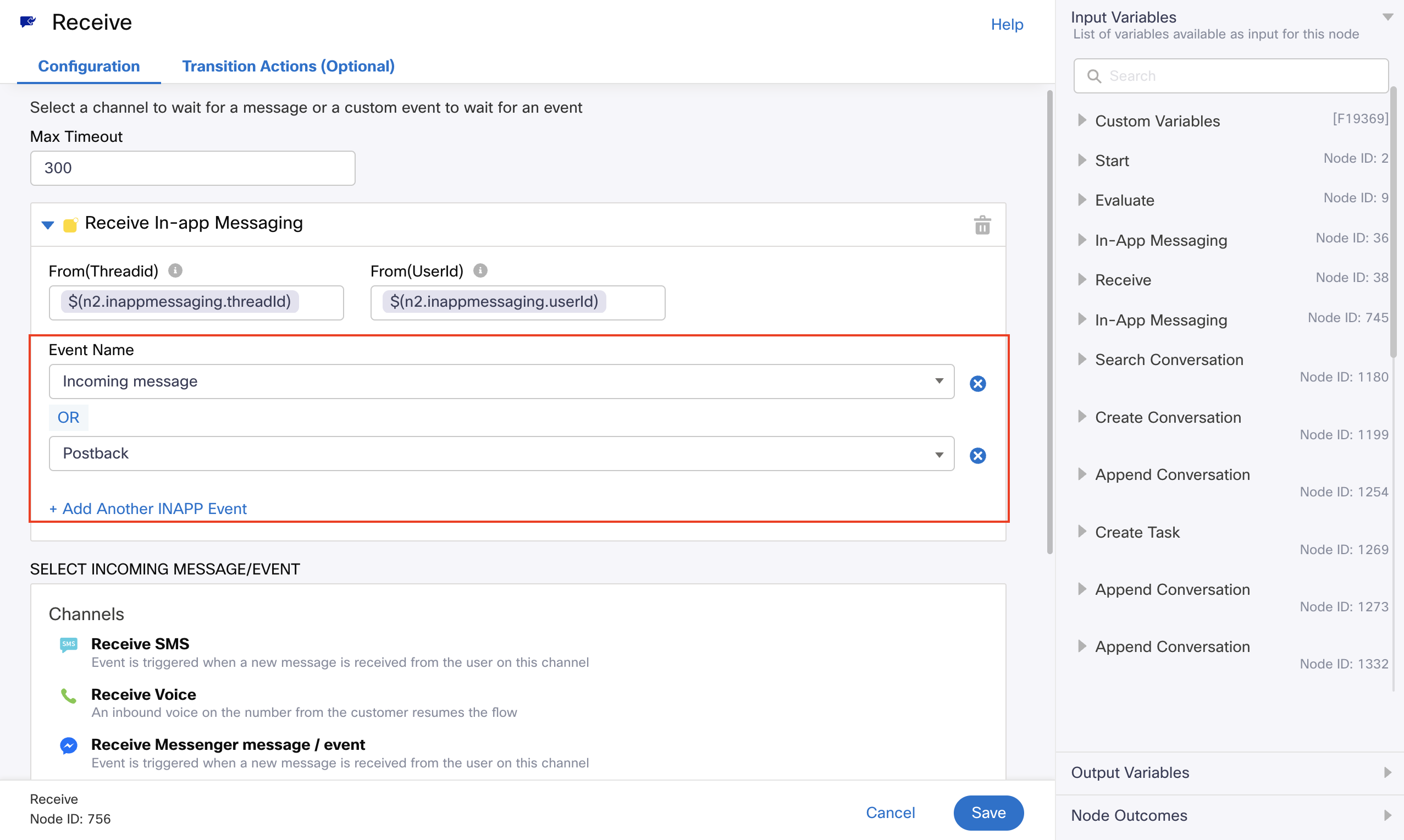
Event names in the receive nodes.
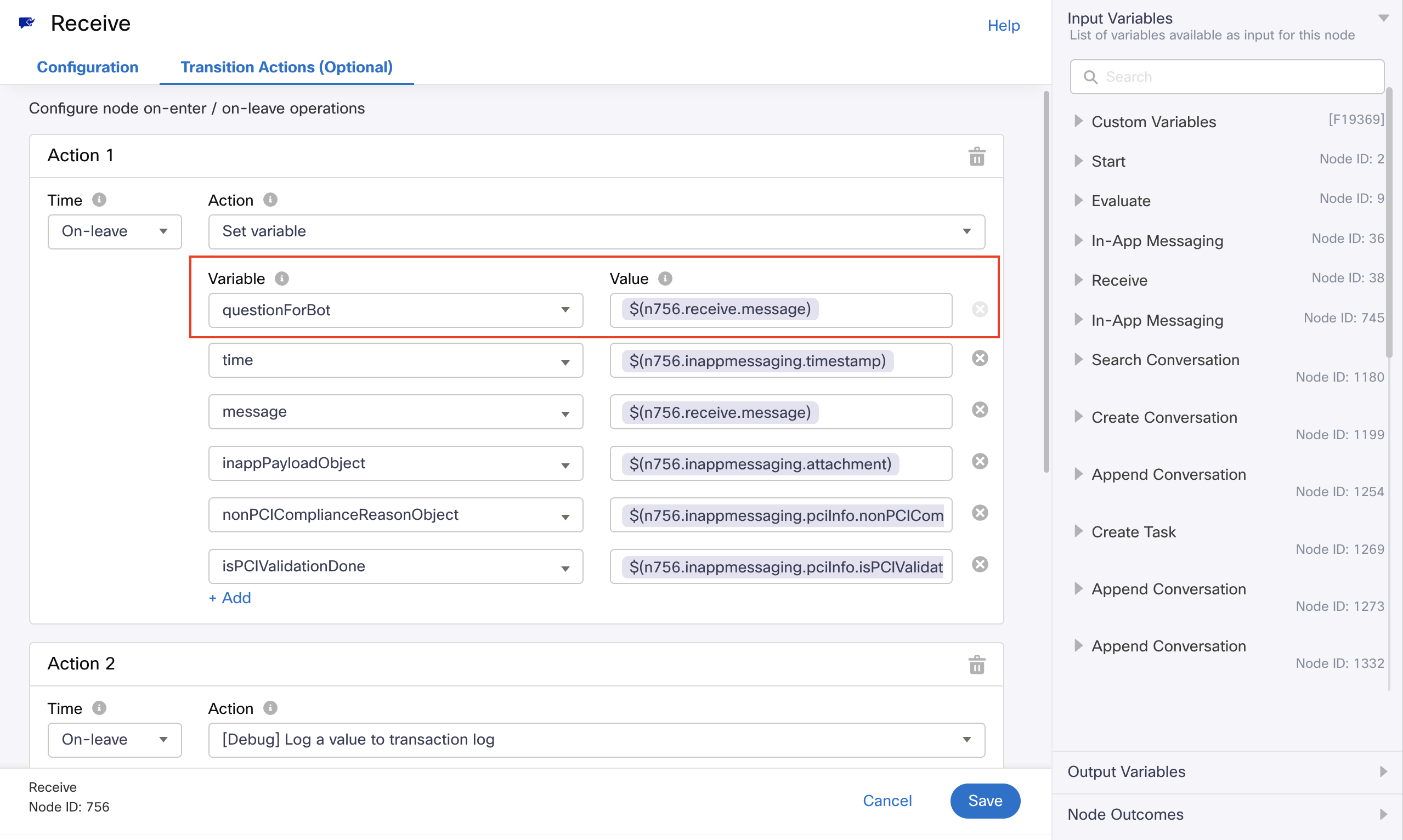
Updating the variable that is used as the input message to bot node.
-
For the app.mo node outcome of the receive nodes in step 6, connect them to the evaluate node for checking PCI compliance and parsing any attachments. This should already be present in your livechat flow. If now, you can use the code and transition actions from the evaluate node in linked sample flow.
-
For each of the 3 branches, use the Append conversation node for incoming user messages. Select the appropriate message type and response object based on the branch.
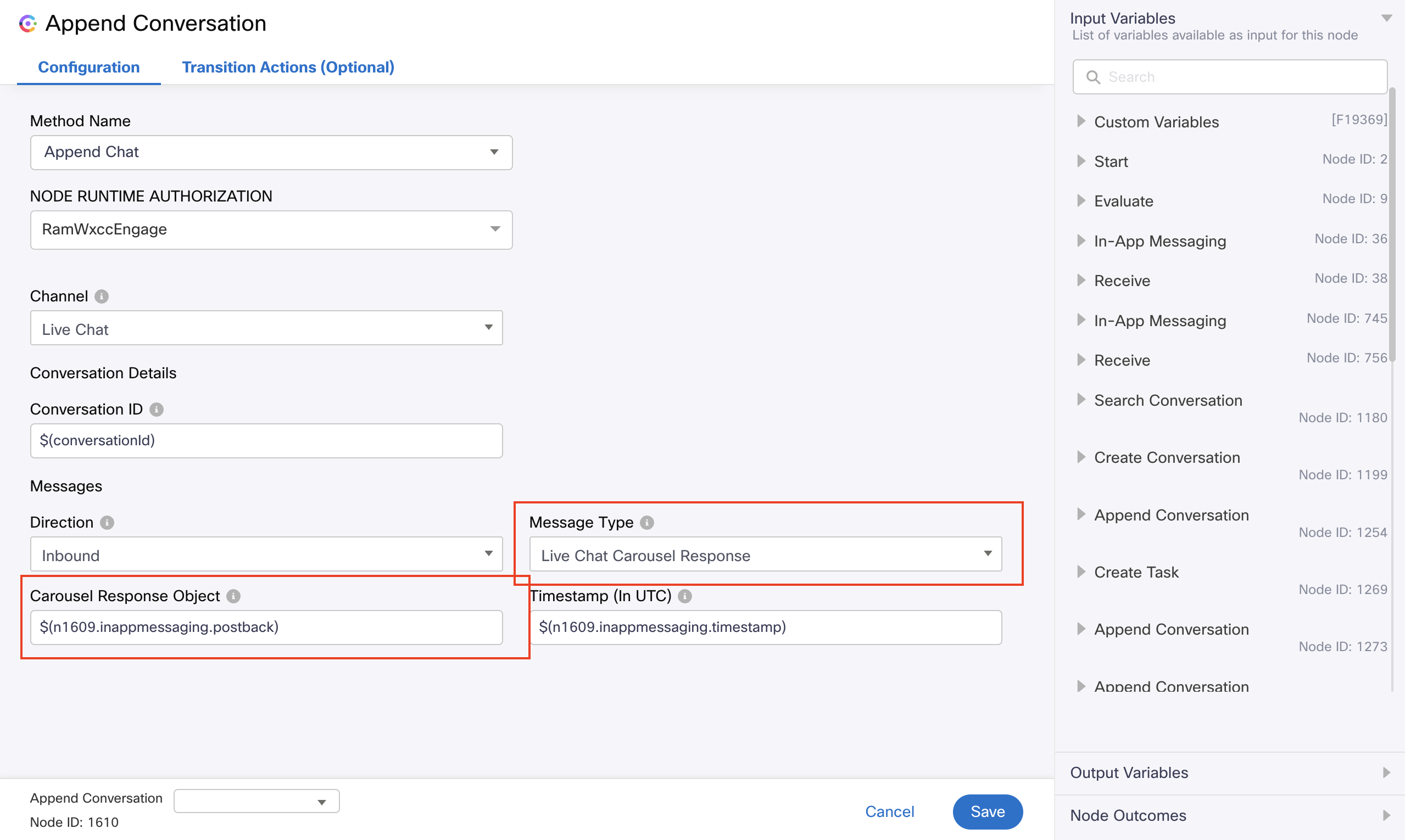
Appending conversation with generic template response received from the user.
- For the branches with app.postback node outcome of the receive nodes in step 6, use a data parser node extract the payload of the button clicked by the user if you wish to send the payload back to the bot as user message. Update the value of the variable that is being used as an input message to the bot node when exiting these data parser nodes.
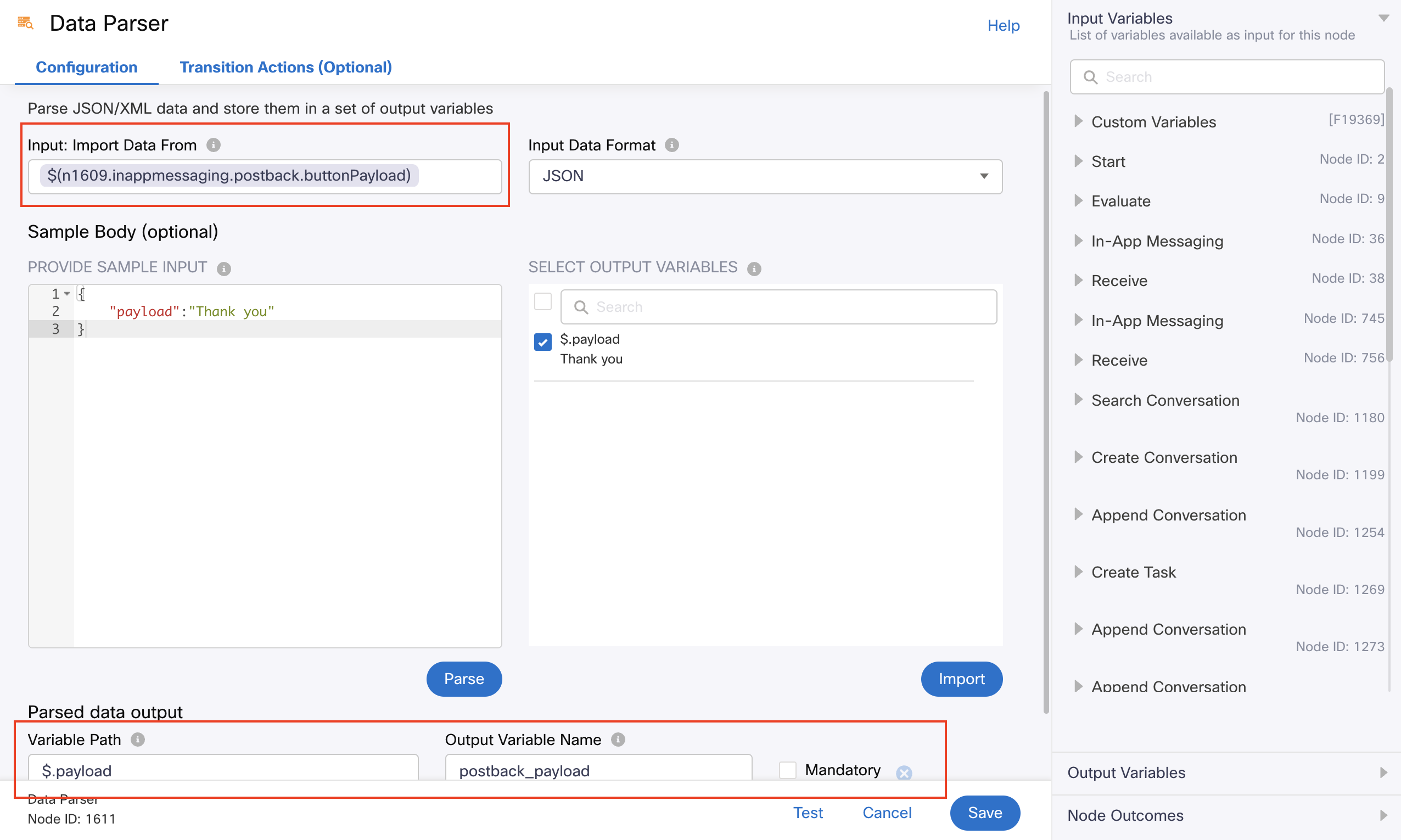
Extracting the payload value from the button clicked by user.
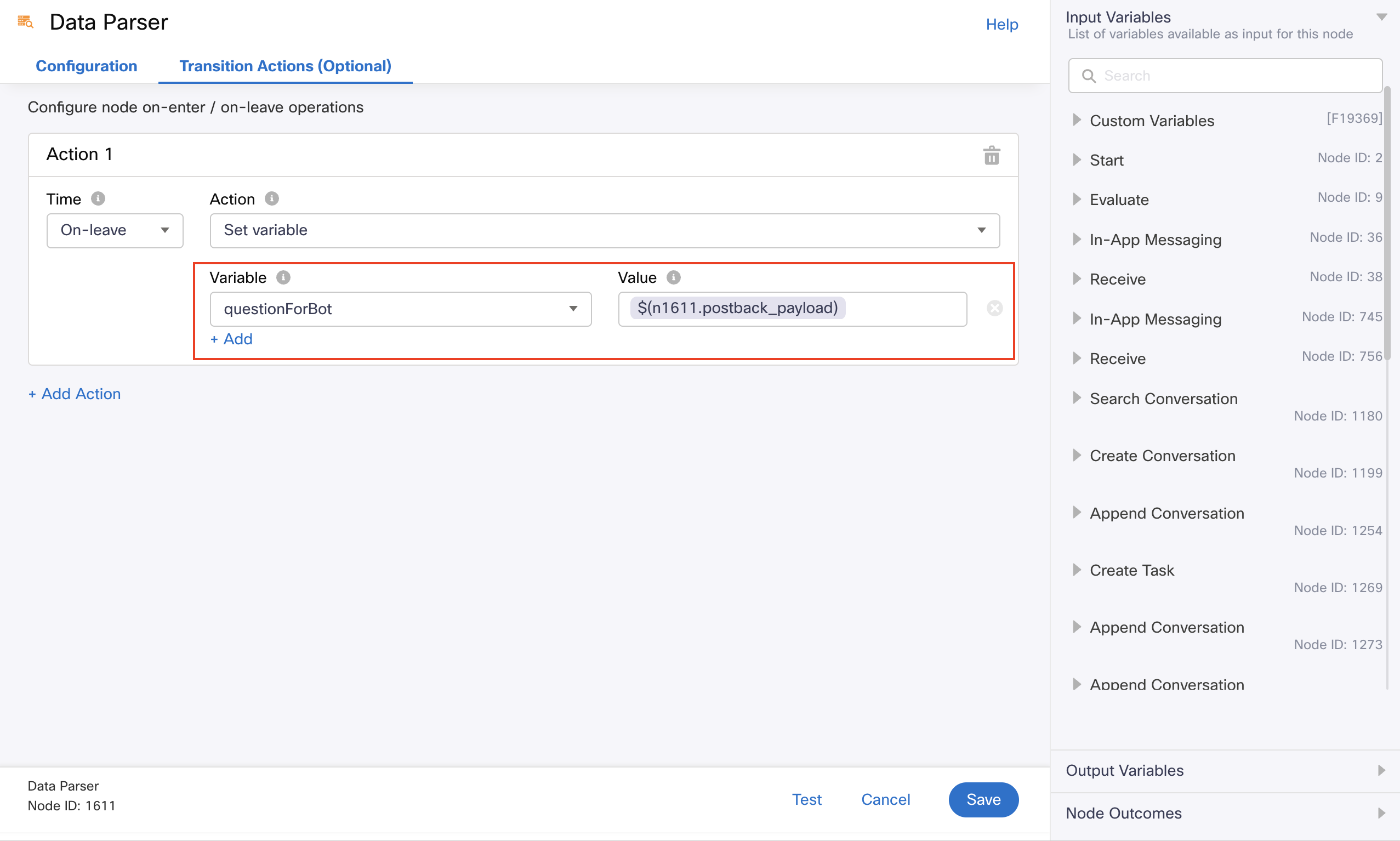
Updating the variable that is used as the input message to bot node.
- Connect the success outcomes of data parser or append conversation nodes back to the bot node in all branches.
Evaluate node code for data transformation
Use the below code for the evaluate node in step 3.
var response = [];
response = JSON.parse(botresponse);
var text = '';
var quick_replies = {};
var generic_template = {};
var response_types = [];
var timern = new Date();
var timestamp = timern.toISOString();
// Array of response types
for (var x = 0; x < response.length; x++) {
response_types.push(Object.keys(response[x]));
}
response_types = [].concat.apply([], response_types); //Flattens array
if (response.length === 0) {
0;
} else if (response[0].hasOwnProperty('text') && response.length === 1) {
text = response[0].text;
1;
} else if (response_types.indexOf('quick_reply') >= 0) {
var pos = response_types.indexOf('quick_reply');
var options = [];
for (var i = 0; i < response[pos].quick_reply.quick_replies.length; i++) {
options[i] = {};
options[i].payload = {};
options[i].title = response[pos].quick_reply.quick_replies[i].title;
options[i].identifier = response[pos].quick_reply.quick_replies[i].title;
options[i].imageUrl = "";
options[i].payload.payload = response[pos].quick_reply.quick_replies[i].payload;
options[i].type = "quickReplyPostback";
}
quick_replies.options = options;
quick_replies.reference = "bot reference";
quick_replies = JSON.stringify(quick_replies);
text = response[pos].quick_reply.text;
2;
} else if (response_types.indexOf('media') >= 0) {
var pos = response_types.indexOf('media');
var elements = [];
for (var i = 0; i < response[pos].media.length; i++) {
elements[i] = {};
elements[i].imageUrls = [];
elements[i].title = response[pos].media[i].title;
elements[i].subtitle = response[pos].media[i].description;
elements[i].imageUrls[0] = response[pos].media[i].url;
elements[i].buttons = [];
for (var j = 0; j < response[pos].media[i].buttons.length; j++) {
elements[i].buttons[j] = {};
elements[i].buttons[j].title = response[pos].media[i].buttons[j].title;
elements[i].buttons[j].identifier = response[pos].media[i].buttons[j].title;
elements[i].buttons[j].payload = {};
if (response[pos].media[i].buttons[j].type === "postback") {
elements[i].buttons[j].type = "templatePostback";
elements[i].buttons[j].payload.payload = response[pos].media[i].buttons[j].payload;
elements[i].buttons[j].url = "";
} else {
elements[i].buttons[j].type = "webUrl";
elements[i].buttons[j].url = response[pos].media[i].buttons[j].url;
}
}
}
for (var k = 0; k < response.length; k++) {
if (response[k].hasOwnProperty('text')) {
text = response[k].text;
}
}
generic_template.elements = elements;
generic_template.reference = "bot reference";
generic_template = JSON.stringify(generic_template);
3;
}
Updated 9 months ago
